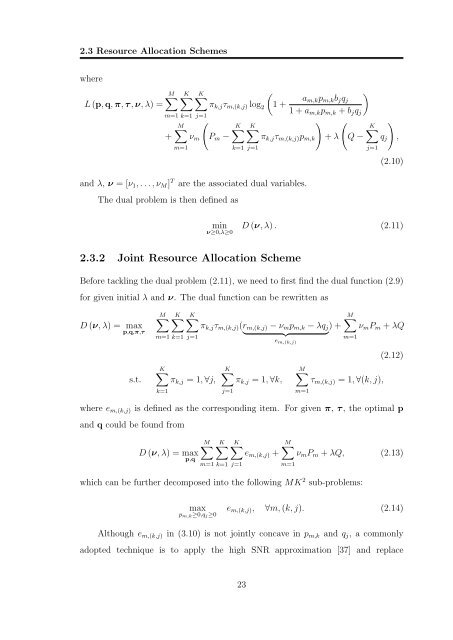Resource Allocation in OFDM Based Wireless Relay Networks ...
Resource Allocation in OFDM Based Wireless Relay Networks ...
Resource Allocation in OFDM Based Wireless Relay Networks ...
Create successful ePaper yourself
Turn your PDF publications into a flip-book with our unique Google optimized e-Paper software.
2.3 <strong>Resource</strong> <strong>Allocation</strong> Schemes<br />
where<br />
M∑ K∑ K∑<br />
)<br />
a m,k p m,k b j q j<br />
L (p, q, π, τ , ν, λ) =<br />
π k,j τ m,(k,j) log 2<br />
(1 +<br />
1 + a<br />
m=1 k=1 j=1<br />
m,k p m,k + b j q j<br />
) ( )<br />
M∑<br />
K∑ K∑<br />
K∑<br />
+ ν m<br />
(P m − π k,j τ m,(k,j) p m,k + λ Q − q j ,<br />
m=1<br />
k=1 j=1<br />
and λ, ν = [ν 1 , . . . , ν M ] T are the associated dual variables.<br />
The dual problem is then def<strong>in</strong>ed as<br />
j=1<br />
(2.10)<br />
m<strong>in</strong><br />
ν≥0,λ≥0<br />
D (ν, λ) . (2.11)<br />
2.3.2 Jo<strong>in</strong>t <strong>Resource</strong> <strong>Allocation</strong> Scheme<br />
Before tackl<strong>in</strong>g the dual problem (2.11), we need to first f<strong>in</strong>d the dual function (2.9)<br />
for given <strong>in</strong>itial λ and ν. The dual function can be rewritten as<br />
D (ν, λ) = max<br />
p,q,π,τ<br />
s.t.<br />
M∑<br />
K∑<br />
K∑<br />
m=1 k=1 j=1<br />
K∑<br />
π k,j = 1, ∀j,<br />
k=1<br />
π k,j τ m,(k,j) (r m,(k,j) − ν m p m,k − λq j ) +<br />
} {{ }<br />
e m,(k,j)<br />
K∑<br />
π k,j = 1, ∀k,<br />
j=1<br />
M∑<br />
ν m P m + λQ<br />
m=1<br />
M∑<br />
τ m,(k,j) = 1, ∀(k, j),<br />
m=1<br />
(2.12)<br />
where e m,(k,j) is def<strong>in</strong>ed as the correspond<strong>in</strong>g item. For given π, τ , the optimal p<br />
and q could be found from<br />
D (ν, λ) = max<br />
p,q<br />
M∑<br />
K∑<br />
m=1 k=1 j=1<br />
K∑<br />
e m,(k,j) +<br />
M∑<br />
ν m P m + λQ, (2.13)<br />
which can be further decomposed <strong>in</strong>to the follow<strong>in</strong>g MK 2 sub-problems:<br />
m=1<br />
max<br />
p m,k ≥0,q j ≥0<br />
e m,(k,j) , ∀m, (k, j). (2.14)<br />
Although e m,(k,j) <strong>in</strong> (3.10) is not jo<strong>in</strong>tly concave <strong>in</strong> p m,k and q j , a commonly<br />
adopted technique is to apply the high SNR approximation [37] and replace<br />
23

















